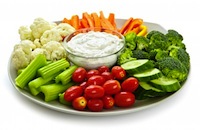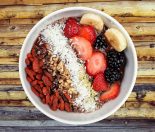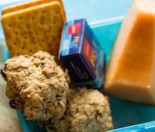Snacks require just as much thought and balance as the other three main meals of the day. Here are some great words of wisdom on healthy snacks for kids from a mum and registered dietitian.
Having children can sometimes mean that you feel like you are constantly thinking of food and what to feed them. No sooner have you organised one meal than they are back wanting something else to eat.
If you choose wisely, snacks can contribute important nutrients to the diet and help to satisfy the appetite. Poor choices can mean a much higher fat or sugar intake and can also mean that your child’s appetite will not be satisfied for long – hence they will be back pestering you for more food before you know it!
Snacks for preschoolers
Very young children eat smaller amounts of food at the main meals and often need a snack in between to keep them fueled up. However it is best if these snacks are offered at regular times rather than allowing your child to graze constantly on food. It is easy to lose track of what they have or have not eaten if snacks are not part of your daily routine.
Try not to give snacks within an hour before a main meal is going to be served. This can dull the appetite and mean your child won’t eat as well at the main meal. Sometimes, especially late afternoon, your child can pester you constantly for food. Rather than giving a steady stream of snacks consider moving their meal forward to a much earlier time. If you can’t move dinner forward, you may need to factor in an additional snack at about 4pm so they can stretch out to a later dinner – it is better to have a planned snack at this time, than a grizzly child round your ankles!
Snacks for school age children
The routine of packing the school lunch box will take care of the morning tea snack for school children. But, as we all know, most children come home from school ready to raid the pantry. Snacks after school should be planned.
A great habit to get your school child into is to sit down to eat a snack after school. Eating at the table allows us to remember what we have eaten and it tends to become more satisfying. Children (and adults!) who eat in front of the television or who can take food to their room or eat on the run can end up eating more over the course of the afternoon.
Having the snack at the table is also a good time for you to sit down with your child and hear about their day.
Snacks for after school activities
Don’t forget to pack some extra food in the lunch box if your child has sports practice, music practice or a job to go to straight after school. To get the best out of their sports performance a snack before practice is essential.
Constant Grazing
By planning the snack it is easier to keep track of what has been eaten. Children can often start looking for food out of boredom, wanting a break from study, responding to a prompt from a television advertisement, or even just from wandering through the kitchen and seeing something they would like to eat. If you know they have eaten a good snack, try encouraging them to go and do something else for 10 minutes, allowing them to come back if they are still hungry after this time. Quite often, it is not genuine hunger that has sent them looking for food, so they will forget about the extra snack they went looking for.
If you have a child who constantly seems to raid the pantry and you are concerned about their weight, try setting up a mini lunch box system for snacks. Pack into it a selection of foods and advise them that they can eat this in the afternoon after school. Once the snack box is empty, they are not allowed to eat any more food.
A drink to go with the snack
As with any meal, including a drink with the snack is vital. Children often don’t think about drinks until they are very thirsty. Encouraging regular fluids with snacks is important to ensure they meet their fluid requirements. The best choice is water or a low fat milk drink.
How much a child needs to eat in between meals depends entirely on their age, weight and activity levels.
Need some suggestions for good snacks?
Try some fruit & veg. options:
- Fresh, canned or dried fruit
- Low fat, fruit yoghurt (can also be frozen in the summer time for a nice cold snack)
- Fruit smoothies – make with milk, yoghurt and add fresh, frozen or canned fruit
- Vegetable sticks – carrot, celery, dip into cottage cheese, humus, tomato salsa.
- Corn on cob – use fresh corn in summer or frozen corn cobs in winter
Cereal based snacks:
- Fruit bread or raisin toast
- Plain popcorn
- Toast, crumpets, hot-cross buns, English muffins – try not to add too much butter or margarine
- Wholegrain crackers with cheese or tomato or relish or vegemite or peanut butter
- Weet-Bix spread with peanut butter and a sliced banana
- Mini pizza – make one using a pita bread / hamburger bun
- Breakfast cereal and fruit
- Toasted sandwich / cheese on toast / mouse traps (see recipe below)
Sweeter options:
- Marshmallows
- Mini muffins with lots of fruit or little savoury muffins – make a batch and freeze them. Use wholemeal flour, not just white flour.
- Plain biscuits (serving size: 1-2) ginger nuts, malt biscuits, hundreds and thousand biscuits, fruit filled biscuits.
Mouse trap recipe:
Heat the oven to 220c and heat the oven tray at the same time, as it needs to be hot.
Use a thin scrape of margarine on a slice of bread, add a thin spread of marmite, and top with a little grated cheese.
Place on hot oven tray and bake 8-10 minutes till golden and crunchy.
These can keep in an airtight container as well.
What about muesli bars?
There is a huge array of muesli bars out there and they all come with wonderful wording which make them sound very good!
You can find these sorts of words on the labels:
- Natural
- Real fruit
- Perfect for lunch boxes
- Excellent source of energy
- No artificial colours or flavours.
However they are often not satisfying, tend to be low in fibre, and are so processed that they do not offer a nutritious option.
What should you look for in a muesli bar?
When you read the nutrition information panel, look for less than 5g fat per bar and less than 9g sugar per bar – or as close to this as you can get.
Remember an apple has around 250kJ . Many muesli bars have around 600 kJ per bar – this is like eating 2 apples at once, but you won’t get the same satisfaction, or the same nutritional value, from a muesli bar.
As for fruit strings or real fruit bars you are much better off serving a piece of fruit to your children than buying these. They may be made from real fruit, but they are more like lollies than fruit!
Snacks for kids
Snacks do have an important role to play in your child’s diet. If you choose healthy nutritious choices they will help ensure your child is energized, allowing for growth and activity. Basing snack choices around wholesome foods instead of processed food will also be a good source of vital nutrients for you child.
Useful Articles:
For more information on suitable drinks for children, see our article on Drinking Fluids
There are also some great tips for Takeaways from our dietitian, Fiona Boyle
For School Lunch ideas for those dreaded lunch boxes visit our great Kiwi Families article.







Mmmmmm I never thought of reading the actual label and stuff on muesli bars thank you guys so much.